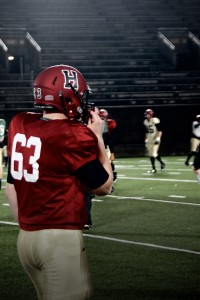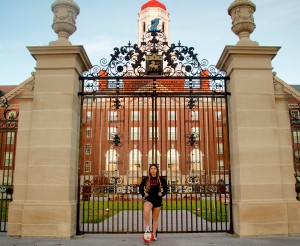Crossing over the Charles River to the Murr Center is an unfamiliar trek for most students, but upon arrival, one suddenly becomes aware of a dynamic foreign to Harvard’s main campus. Students stroll outside athletics complexes clad in workout gear with the university’s insignia, a symbol of their belonging. The Murr Center is theirs, a campus away from campus. When they leave, crossing Anderson Memorial Bridge back into Cambridge, they also leave an aspect of their athletic identity behind.
While non-athletes can certainly identify athletes, most students only enter their world once every other year during the Harvard-Yale football game. This unfamiliarity with Harvard’s athletic department lends itself to gaps in knowledge often filled with assumptions, some of which inadvertently turn into stigmas. In this way, there is a general ignorance regarding the athletic department at Harvard despite administrative efforts to increase the student body’s participation.
Although there are few external or institutional structures that separate athletes from the remainder of the student body, there remains an unspoken disconnect between the two, which often feeds into stereotypes about athletes’ academic abilities. In most other schools, this distinction is rooted in the privileges athletes receive, but at Harvard these benefits are absent. The question stands: why choose Harvard?
TWO WORLDS
It is not wrong to assume that the colloquial use of the term “Ivy League” has departed from its original inception as an athletic conference. Unlike big sports schools like Vanderbilt or the University of North Carolina, athletics at Harvard is rarely seen as more than just another extracurricular activity. Athletes at Harvard neither have their own separate dining halls nor an unofficial athlete dorm. This difference is evidence that athlete integration is one of Harvard’s priorities; it makes the efforts many schools overlook. Yet, unless they are athletes themselves, most Harvard students pay little attention, if any, to sports.
Men’s basketball team member Nehizena Edosomwan ’17 believes that athletics will never surpass academics given Harvard’s history and legacy. However, with the men’s basketball team making it to the NCAA Division I tournament for the past four consecutive years, Edosomwan thinks the public is beginning to recognize that Harvard’s talent does extend to the court—even if it remains secondary to Harvard’s established reputation as a leader in academics.
For the most part, attending sports games and rallying for Harvard is rarely an investment students are willing to make. Total attendance for all varsity male sports at Harvard in 2014 was 75,000 people, significantly less than the 480,000 people sports at the University of Notre Dame attract, for example. Yet with over 20 percent of the freshman class on a varsity team, athletics are a significant part of the university, despite the absence of a traditional sports culture. Given the little attention Harvard’s athletic program receives both within the school and in the public eye, Harvard seems like a counterintuitive choice for varsity athletes. However, football team captain and linebacker Matt Koran ’16 described his decision to come to Harvard as being “not a four-year decision, but a 40-year decision.”
Harvard provides the best of both worlds in terms of academics and athletics. To athletes who do not see themselves pursuing athletics after college, Harvard supplies a strong academic background and provides a variety of other options at college.
“The culture at Harvard always has you looking towards the next step. … I appreciate that because it reminds me that there’s more of the world out there than just athletics, and it gives me something to look forward to,” said Edosomwan. Though he hopes to pursue basketball after college, he also realizes that success in professional athletics is never guaranteed and thus values the emphasis Harvard places on academics, which offers an alternate career path.
THE BEST OF BOTH WORLDS
The decision to pursue athletics at Harvard is always two-fold—student athletes come to Harvard for both its intensive athletic and academic environments. For students who choose not to pursue athletics after college, Harvard’s education provides alternative opportunities that they would not receive at the same caliber in other schools. Harvard is rarely considered a “sports school,” and not for a lack of passion or success in athletics, but because athletics is not the end goal for most student athletes. Cole Toner ’16, an offensive lineman for the Harvard football team, also aspires to play professional sports after college. Yet if given the chance to go to a bigger sports school, he would choose Harvard again. “I don’t know if I ever would have strayed from [Harvard], because I envisioned a future for myself that wasn’t sports-related,” he said. Like Edosomwan, Toner recognizes that there are so many external factors that affect professional athletics that he can never guarantee success in this career.
environments. For students who choose not to pursue athletics after college, Harvard’s education provides alternative opportunities that they would not receive at the same caliber in other schools. Harvard is rarely considered a “sports school,” and not for a lack of passion or success in athletics, but because athletics is not the end goal for most student athletes. Cole Toner ’16, an offensive lineman for the Harvard football team, also aspires to play professional sports after college. Yet if given the chance to go to a bigger sports school, he would choose Harvard again. “I don’t know if I ever would have strayed from [Harvard], because I envisioned a future for myself that wasn’t sports-related,” he said. Like Edosomwan, Toner recognizes that there are so many external factors that affect professional athletics that he can never guarantee success in this career.
The idea of attending Harvard for its academic “safety-net” feeds into the stereotype that to many varsity athletes at Harvard, sports are either a means to an end or compensation for any academic shortcomings during the admissions process. However, during recruitment, Harvard only offers players positions if they match the school’s academic requirements first. Women’s crew co-captain Genevieve Mulligan ’16 made note of the fact that the team has been unable to accept talented potential team members because they did not meet Harvard’s academic criteria. Koran also emphasized the importance of academics in athletic recruitment, explaining that he did not consider Ivy teams until he learned that he had scored well on his ACTs.
The level of academic performance required of Harvard’s athletes often goes unrecognized. Mulligan recalled that she has witnessed recruits’ academic capabilities being belittled. “There is absolutely a difference between how people see recruited athletes versus non-recruited athletes,” she said. As a walk-on herself, Mulligan has noticed that when people mistake her for a recruited athlete, they tend to assume that her acceptance to Harvard relied primarily on her athleticism rather than her intellect—an assumption that changes upon learning that she is a walk-on. When other students overlook athletes for their academic achievements, they are discrediting student-athletes’ hard work, said Edosomwan. Some people think that if someone is “an athlete, it’s a lot easier … but it’s not easier,” he asserted. On the opposite side of the same issue, because Harvard is an elite academic institution but is not necessarily recognized as an elite athletic institution, it may seem that varsity athletes do not challenge themselves athletically by choosing Harvard. However, Harvard’s academic expectations translate to athletics as well. Being an athlete requires both mental and physical energy, and is as much a priority as academics to many athletes.
Between practices and games, athletics can be a 20-hour per week commitment. Thus, it forces students to strike a balance between two demanding workloads. “Harvard pushes you in a different way [than other schools]. You have to learn to balance something incredible and intense and hard,” Mulligan explained. She joined the crew team as a walk-on, having rowed in high school. She initially hesitated when making the decision due to the large commitment it entailed, but eventually realized that she “wanted that structure back in [her] life.” It is Harvard’s successful balance of academics and sports that attracts so many athletes, but the high expectations Harvard places on students to do well in the classroom and in their respective sports is also an incredible challenge.
WORLDS COLLIDING
Perhaps what separates Harvard from most other schools is its ability to integrate athletes into the rest of the college community. Harvard strives toward providing non-athletes and athletes with equal facilities, therefore athletes do not have a separate dining hall or dormitory. Toner believes that it is because of this integration that Harvard athletes feel minimally isolated from the general student body; he noted that athletes are much less stigmatized at Harvard than those at bigger sports schools. While athletes at Harvard surely have their own community, it does not exist as a segregated bubble from the rest of the school, but rather as just one of the many sub-communities within the greater Harvard community.
Despite the growing athletic culture at Harvard, it is unlikely that Harvard will ever be classified as a sports school. Furthermore, Harvard athletes are often actively encouraged by the administration and their coaches to prioritize academics over athletics. Despite the potential limitations these mindsets pose in building a successful athletic program, Harvard has no trouble attracting athletes. So what motivates students to pursue an athletic career at Harvard? Perhaps Koran put it best: Harvard athletes stay on the field “for the sheer love of the game.”
Image credit: Kyle McFadden/HPR
